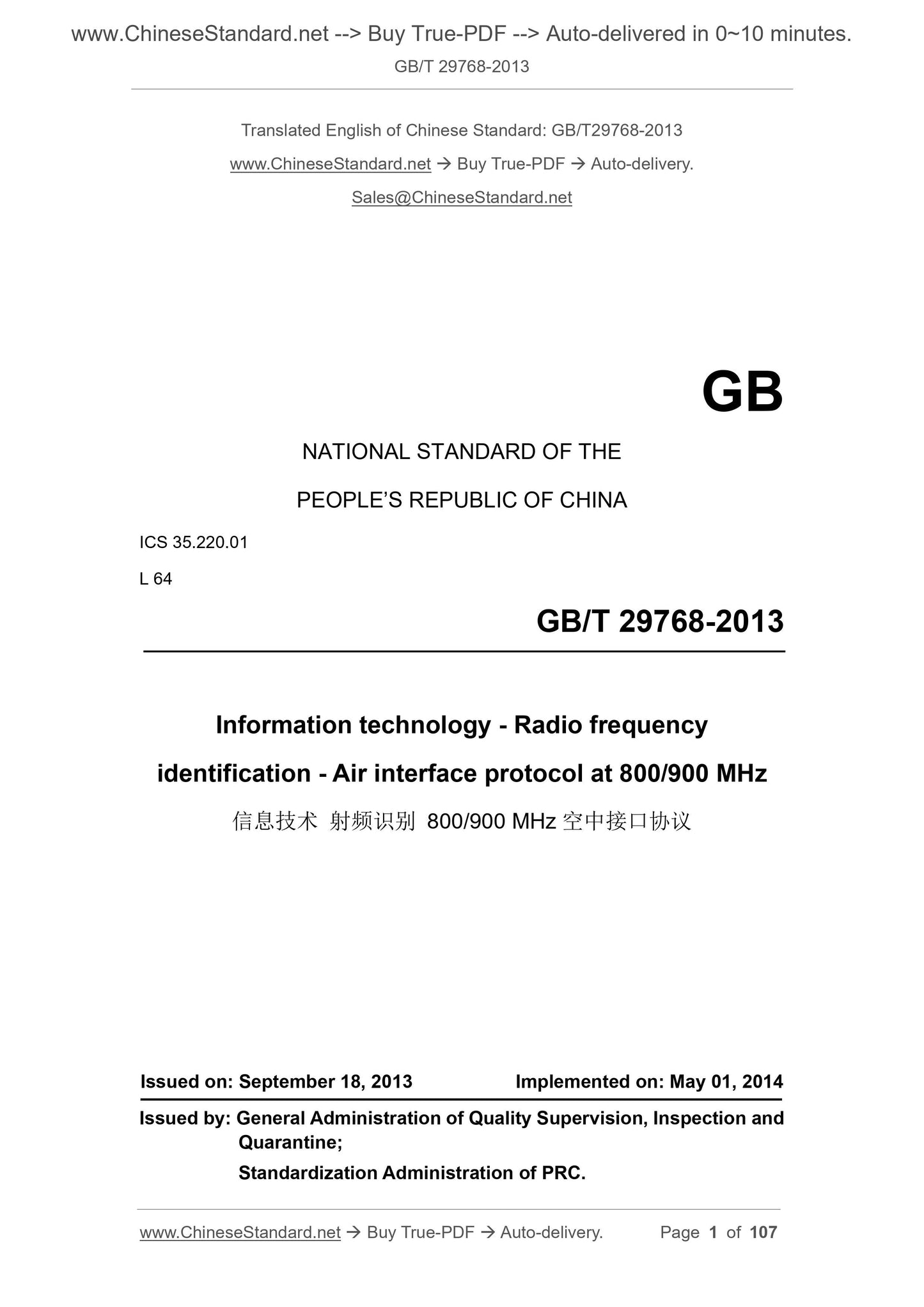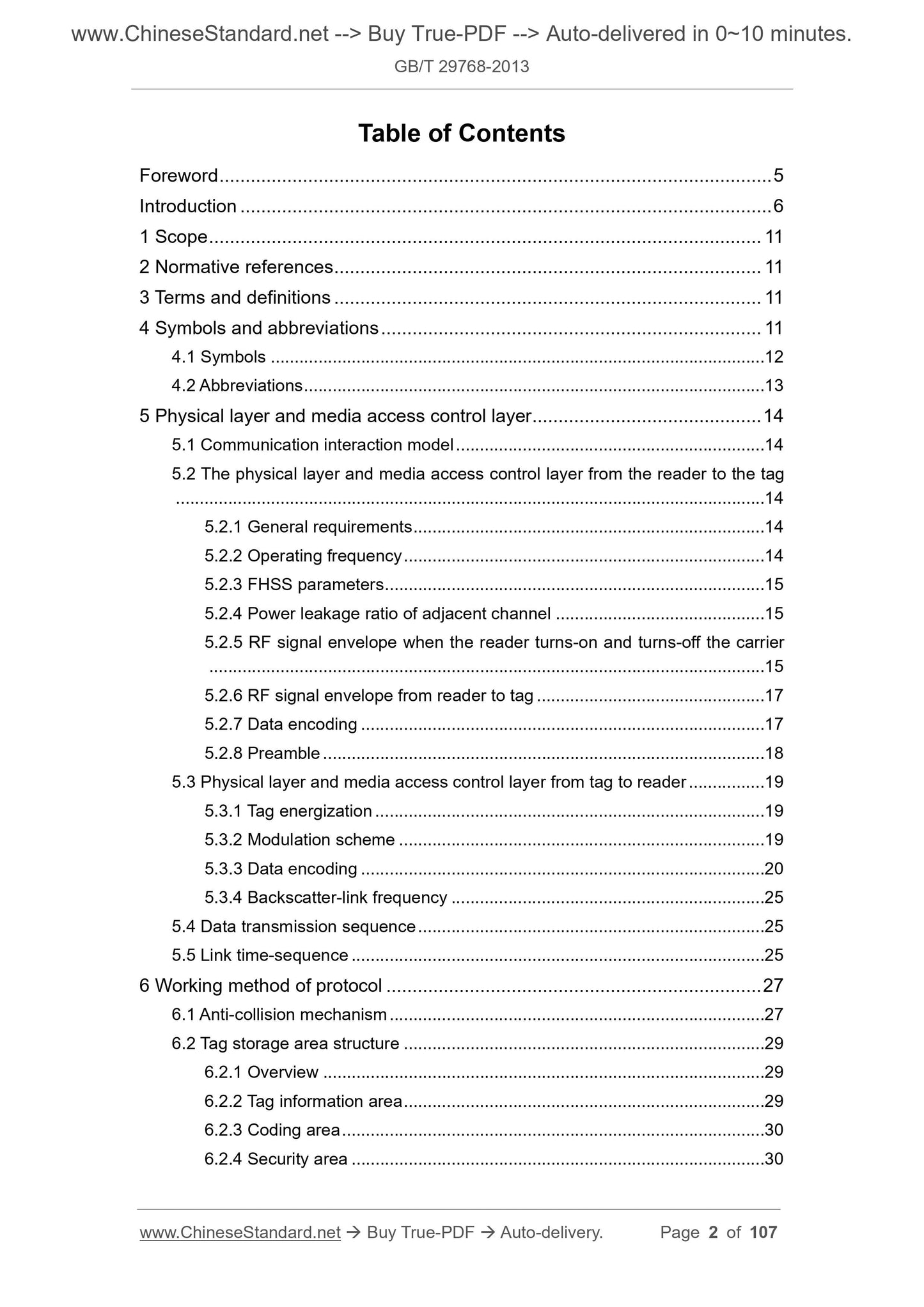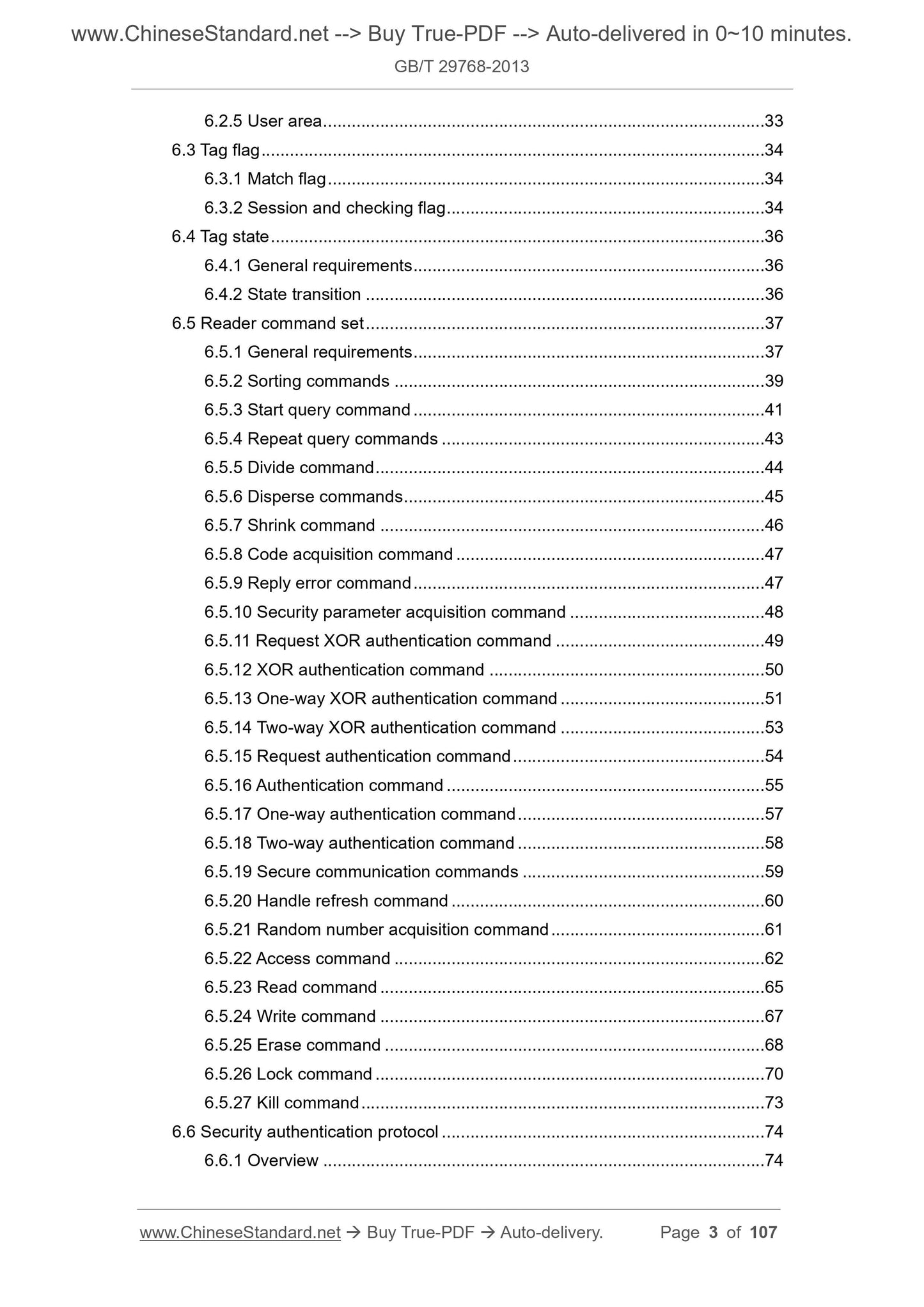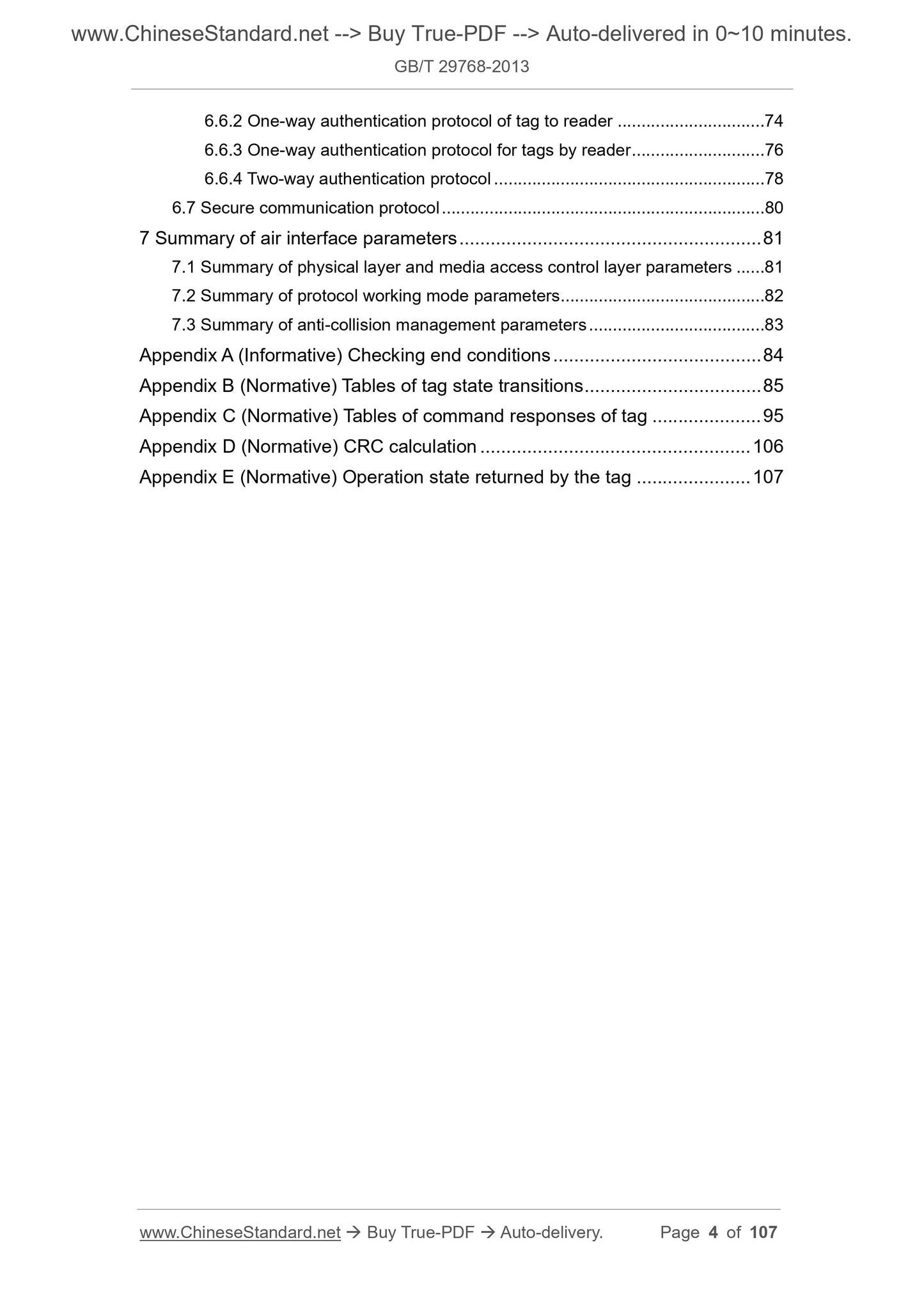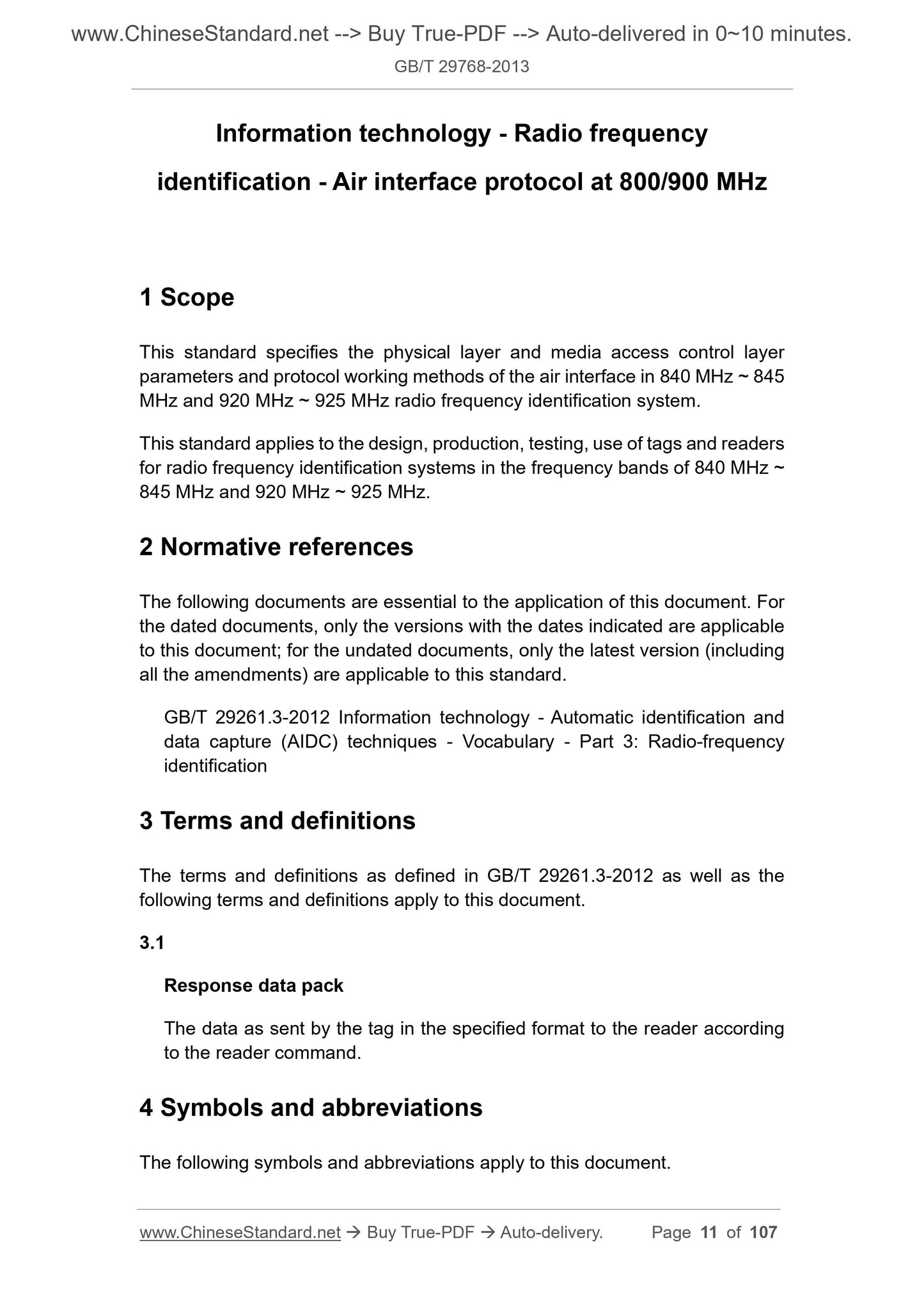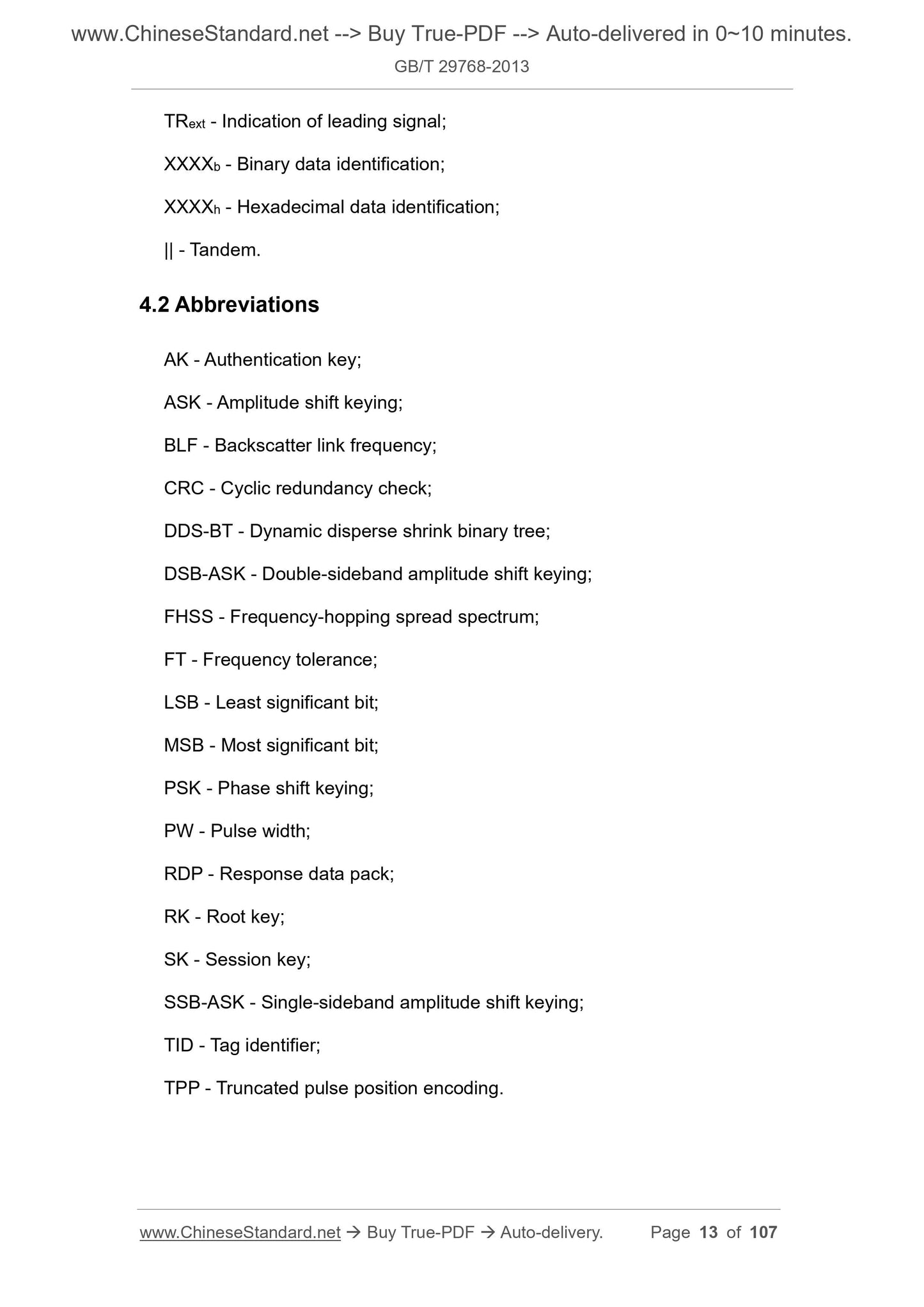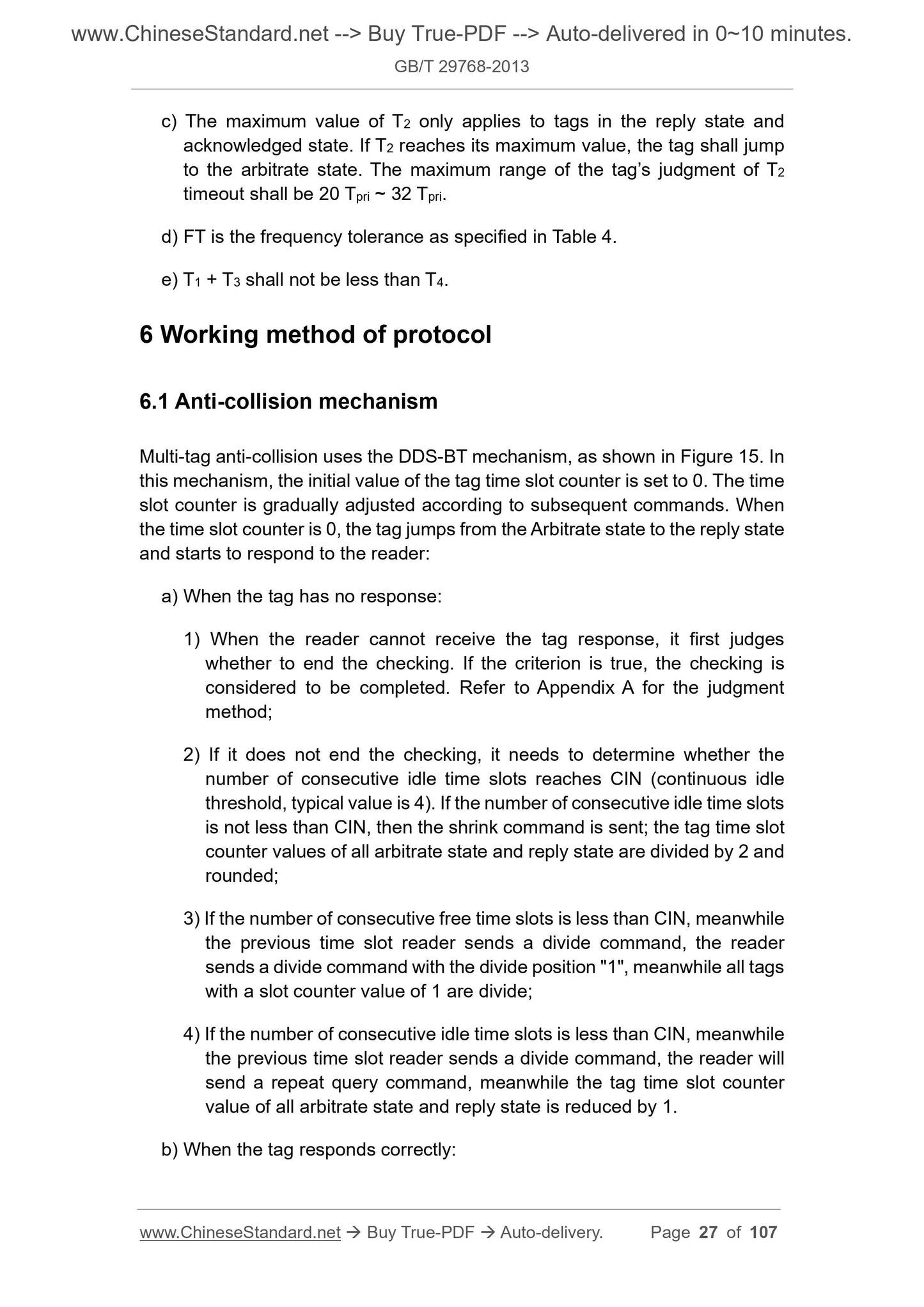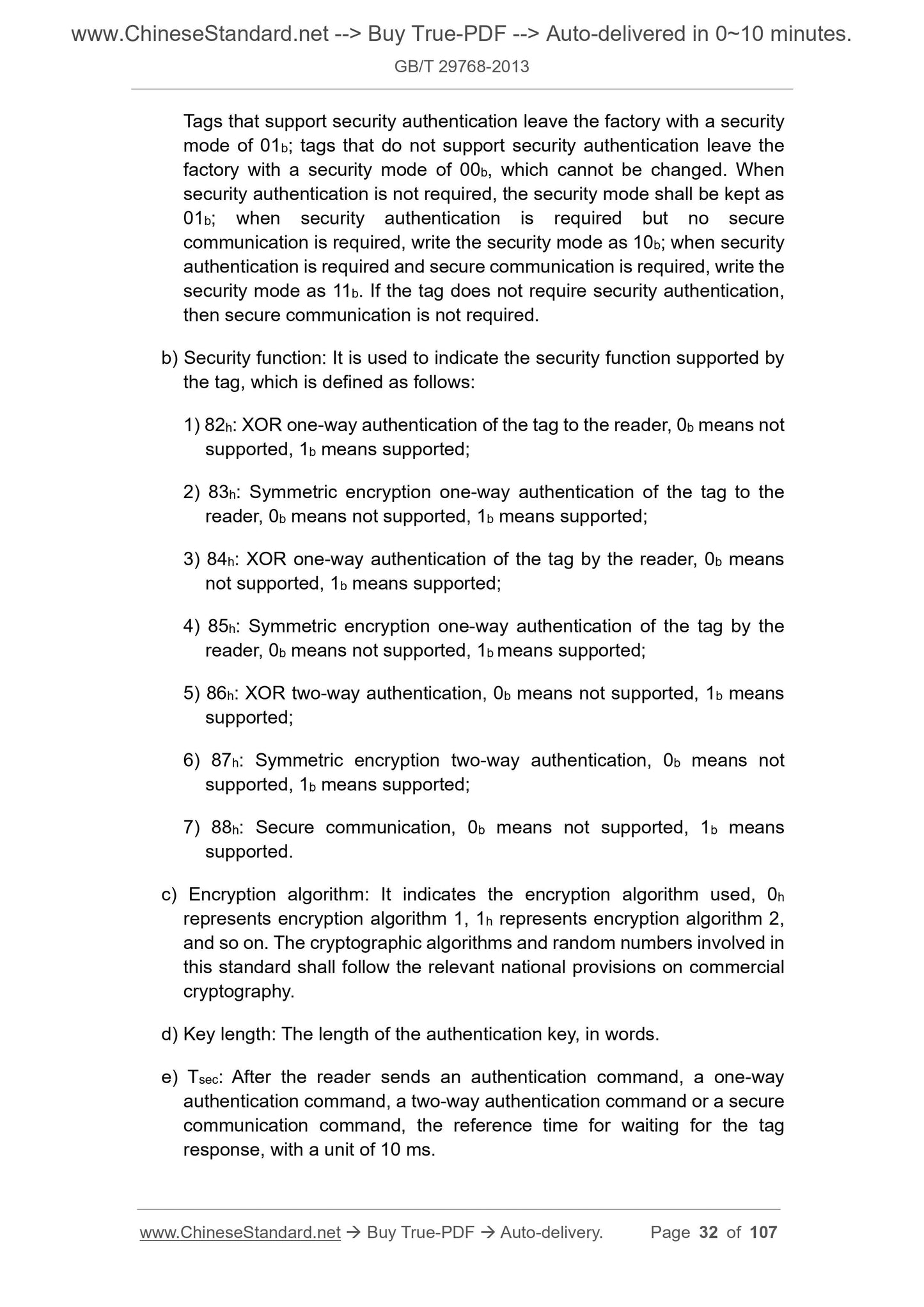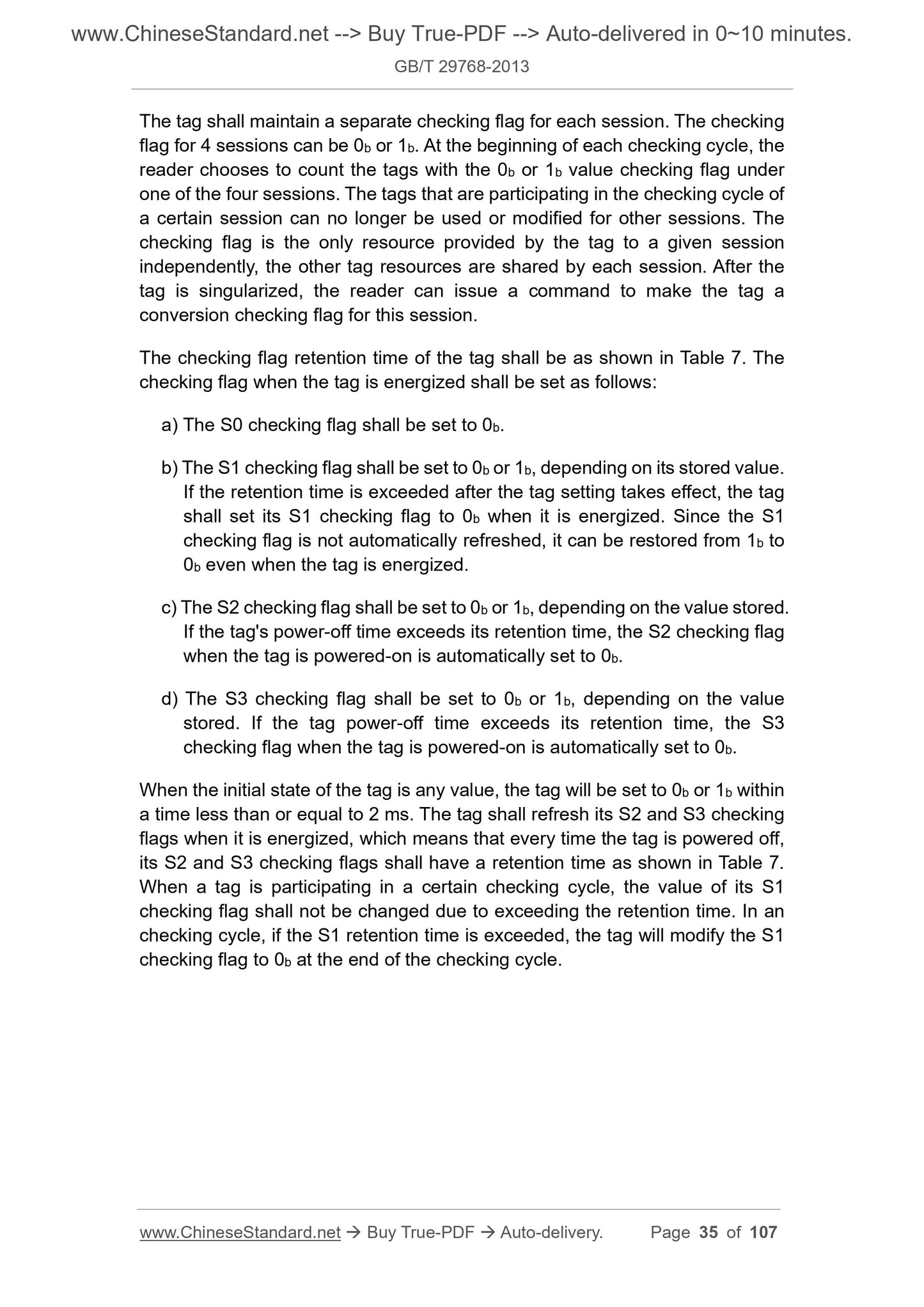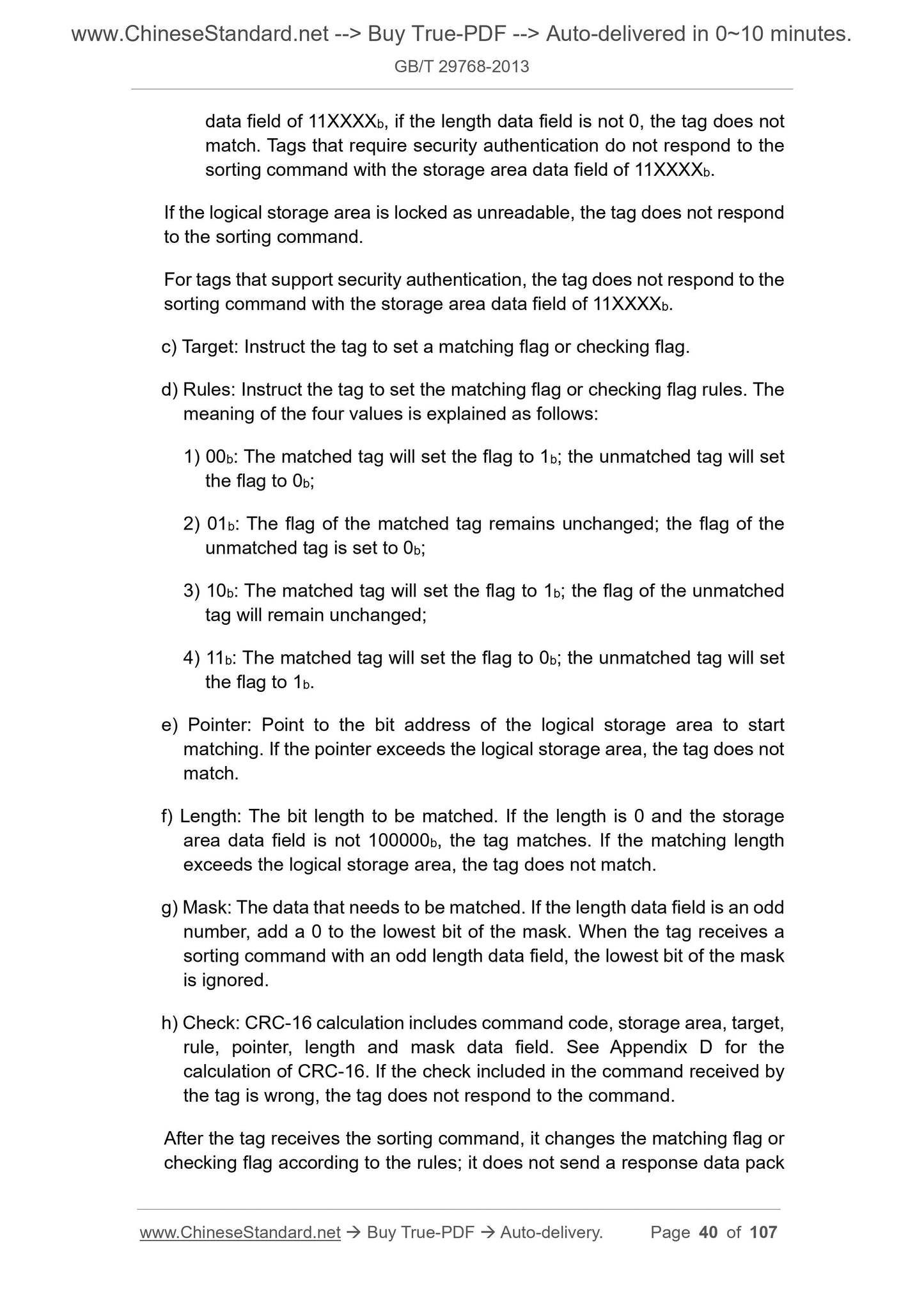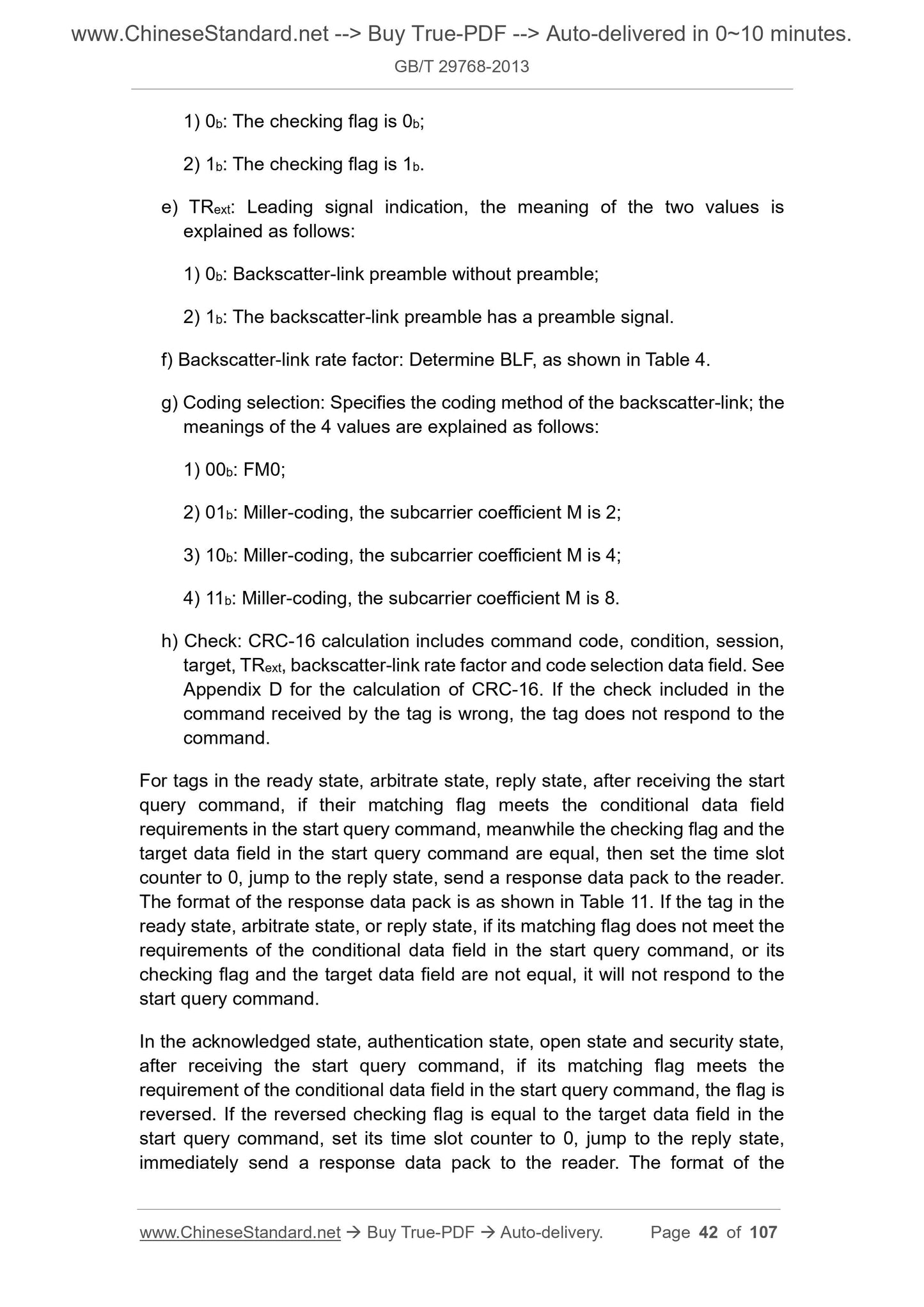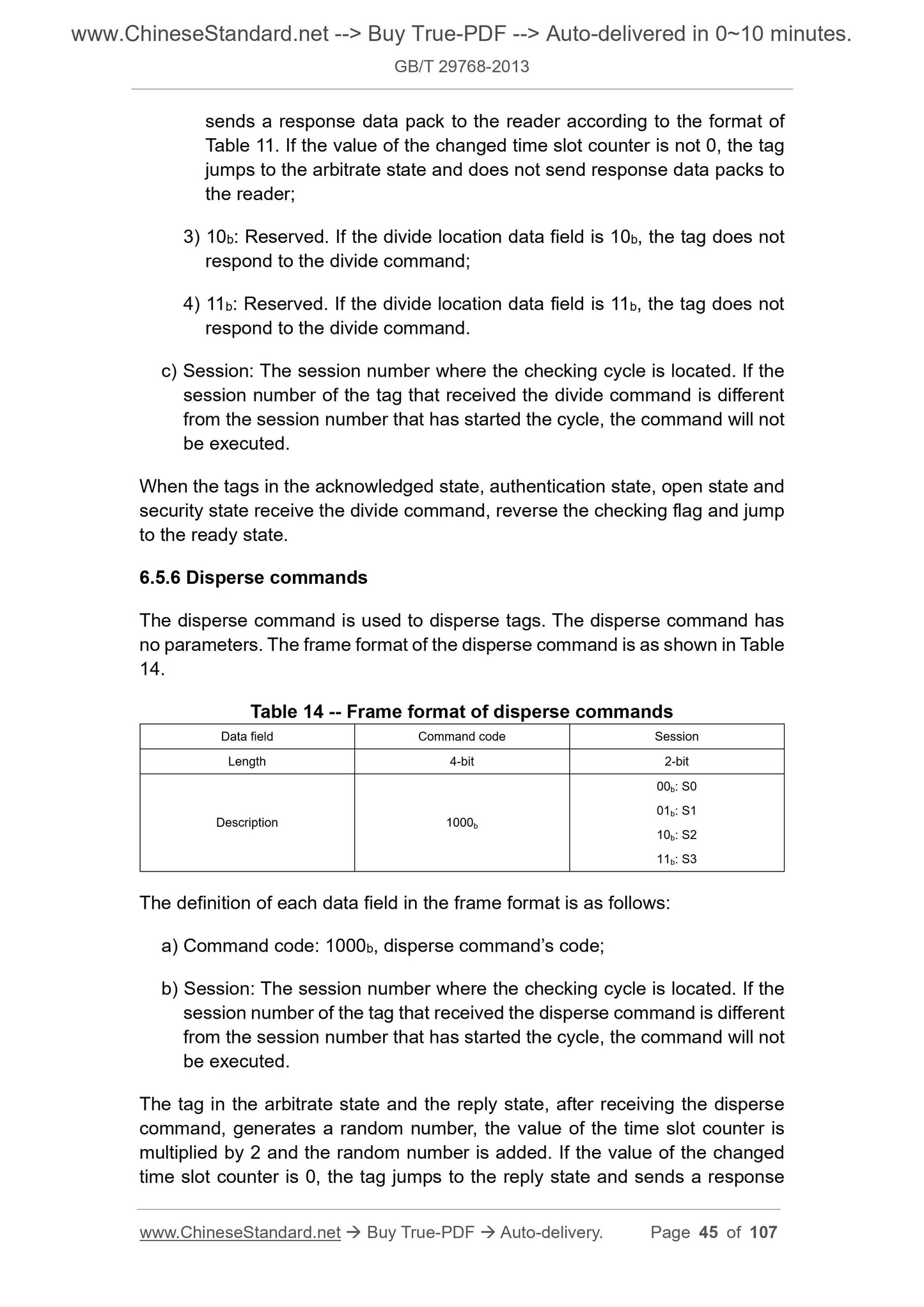1
/
of
12
PayPal, credit cards. Download editable-PDF and invoice in 1 second!
GB/T 29768-2013 English PDF (GBT29768-2013)
GB/T 29768-2013 English PDF (GBT29768-2013)
Regular price
$555.00 USD
Regular price
Sale price
$555.00 USD
Unit price
/
per
Shipping calculated at checkout.
Couldn't load pickup availability
Delivery: 3 seconds. Download true-PDF + Invoice.
Get QUOTATION in 1-minute: Click GB/T 29768-2013
Historical versions: GB/T 29768-2013
Preview True-PDF (Reload/Scroll if blank)
GB/T 29768-2013: Information technology -- Radio frequency identification -- Air interface protocol at 800/900 MHz
GB/T 29768-2013
GB
NATIONAL STANDARD OF THE
PEOPLE’S REPUBLIC OF CHINA
ICS 35.220.01
L 64
Information technology - Radio frequency
identification - Air interface protocol at 800/900 MHz
ISSUED ON: SEPTEMBER 18, 2013
IMPLEMENTED ON: MAY 01, 2014
Issued by: General Administration of Quality Supervision, Inspection and
Quarantine;
Standardization Administration of PRC.
Table of Contents
Foreword ... 5
Introduction ... 6
1 Scope ... 11
2 Normative references ... 11
3 Terms and definitions ... 11
4 Symbols and abbreviations ... 11
4.1 Symbols ... 12
4.2 Abbreviations ... 13
5 Physical layer and media access control layer ... 14
5.1 Communication interaction model ... 14
5.2 The physical layer and media access control layer from the reader to the tag
... 14
5.2.1 General requirements ... 14
5.2.2 Operating frequency ... 14
5.2.3 FHSS parameters ... 15
5.2.4 Power leakage ratio of adjacent channel ... 15
5.2.5 RF signal envelope when the reader turns-on and turns-off the carrier
... 15
5.2.6 RF signal envelope from reader to tag ... 17
5.2.7 Data encoding ... 17
5.2.8 Preamble ... 18
5.3 Physical layer and media access control layer from tag to reader ... 19
5.3.1 Tag energization ... 19
5.3.2 Modulation scheme ... 19
5.3.3 Data encoding ... 20
5.3.4 Backscatter-link frequency ... 25
5.4 Data transmission sequence ... 25
5.5 Link time-sequence ... 25
6 Working method of protocol ... 27
6.1 Anti-collision mechanism ... 27
6.2 Tag storage area structure ... 29
6.2.1 Overview ... 29
6.2.2 Tag information area ... 29
6.2.3 Coding area ... 30
6.2.4 Security area ... 30
6.2.5 User area ... 33
6.3 Tag flag ... 34
6.3.1 Match flag ... 34
6.3.2 Session and checking flag ... 34
6.4 Tag state ... 36
6.4.1 General requirements ... 36
6.4.2 State transition ... 36
6.5 Reader command set ... 37
6.5.1 General requirements ... 37
6.5.2 Sorting commands ... 39
6.5.3 Start query command ... 41
6.5.4 Repeat query commands ... 43
6.5.5 Divide command ... 44
6.5.6 Disperse commands ... 45
6.5.7 Shrink command ... 46
6.5.8 Code acquisition command ... 47
6.5.9 Reply error command ... 47
6.5.10 Security parameter acquisition command ... 48
6.5.11 Request XOR authentication command ... 49
6.5.12 XOR authentication command ... 50
6.5.13 One-way XOR authentication command ... 51
6.5.14 Two-way XOR authentication command ... 53
6.5.15 Request authentication command ... 54
6.5.16 Authentication command ... 55
6.5.17 One-way authentication command ... 57
6.5.18 Two-way authentication command ... 58
6.5.19 Secure communication commands ... 59
6.5.20 Handle refresh command ... 60
6.5.21 Random number acquisition command ... 61
6.5.22 Access command ... 62
6.5.23 Read command ... 65
6.5.24 Write command ... 67
6.5.25 Erase command ... 68
6.5.26 Lock command ... 70
6.5.27 Kill command ... 73
6.6 Security authentication protocol ... 74
6.6.1 Overview ... 74
6.6.2 One-way authentication protocol of tag to reader ... 74
6.6.3 One-way authentication protocol for tags by reader ... 76
6.6.4 Two-way authentication protocol ... 78
6.7 Secure communication protocol ... 80
7 Summary of air interface parameters ... 81
7.1 Summary of physical layer and media access control layer parameters ... 81
7.2 Summary of protocol working mode parameters ... 82
7.3 Summary of anti-collision management parameters ... 83
Appendix A (Informative) Checking end conditions ... 84
Appendix B (Normative) Tables of tag state transitions ... 85
Appendix C (Normative) Tables of command responses of tag ... 95
Appendix D (Normative) CRC calculation ... 106
Appendix E (Normative) Operation state returned by the tag ... 107
Information technology - Radio frequency
identification - Air interface protocol at 800/900 MHz
1 Scope
This standard specifies the physical layer and media access control layer
parameters and protocol working methods of the air interface in 840 MHz ~ 845
MHz and 920 MHz ~ 925 MHz radio frequency identification system.
This standard applies to the design, production, testing, use of tags and readers
for radio frequency identification systems in the frequency bands of 840 MHz ~
845 MHz and 920 MHz ~ 925 MHz.
2 Normative references
The following documents are essential to the application of this document. For
the dated documents, only the versions with the dates indicated are applicable
to this document; for the undated documents, only the latest version (including
all the amendments) are applicable to this standard.
GB/T 29261.3-2012 Information technology - Automatic identification and
data capture (AIDC) techniques - Vocabulary - Part 3: Radio-frequency
identification
3 Terms and definitions
The terms and definitions as defined in GB/T 29261.3-2012 as well as the
following terms and definitions apply to this document.
3.1
Response data pack
The data as sent by the tag in the specified format to the reader according
to the reader command.
4 Symbols and abbreviations
The following symbols and abbreviations apply to this document.
TRext - Indication of leading signal;
XXXXb - Binary data identification;
XXXXh - Hexadecimal data identification;
|| - Tandem.
4.2 Abbreviations
AK - Authentication key;
ASK - Amplitude shift keying;
BLF - Backscatter link frequency;
CRC - Cyclic redundancy check;
DDS-BT - Dynamic disperse shrink binary tree;
DSB-ASK - Double-sideband amplitude shift keying;
FHSS - Frequency-hopping spread spectrum;
FT - Frequency tolerance;
LSB - Least significant bit;
MSB - Most significant bit;
PSK - Phase shift keying;
PW - Pulse width;
RDP - Response data pack;
RK - Root key;
SK - Session key;
SSB-ASK - Single-sideband amplitude shift keying;
TID - Tag identifier;
TPP - Truncated pulse position encoding.
c) The maximum value of T2 only applies to tags in the reply state and
acknowledged state. If T2 reaches its maximum value, the tag shall jump
to the arbitrate state. The maximum range of the tag’s judgment of T2
timeout shall be 20 Tpri ~ 32 Tpri.
d) FT is the frequency tolerance as specified in Table 4.
e) T1 + T3 shall not be less than T4.
6 Working method of protocol
6.1 Anti-collision mechanism
Multi-tag anti-collision uses the DDS-BT mechanism, as shown in Figure 15. In
this mechanism, the initial value of the tag time slot counter is set to 0. The time
slot counter is gradually adjusted according to subsequent commands. When
the time slot counter is 0, the tag jumps from the Arbitrate state to the reply state
and starts to respond to the reader:
a) When the tag has no response:
1) When the reader cannot receive the tag response, it first judges
whether to end the checking. If the criterion is true, the checking is
considered to be completed. Refer to Appendix A for the judgment
method;
2) If it does not end the checking, it needs to determine whether the
number of consecutive idle time slots reaches CIN (continuous idle
threshold, typical value is 4). If the number of consecutive idle time slots
is not less than CIN, then the shrink command is sent; the tag time slot
counter values of all arbitrate state and reply state are divided by 2 and
rounded;
3) If th...
Get QUOTATION in 1-minute: Click GB/T 29768-2013
Historical versions: GB/T 29768-2013
Preview True-PDF (Reload/Scroll if blank)
GB/T 29768-2013: Information technology -- Radio frequency identification -- Air interface protocol at 800/900 MHz
GB/T 29768-2013
GB
NATIONAL STANDARD OF THE
PEOPLE’S REPUBLIC OF CHINA
ICS 35.220.01
L 64
Information technology - Radio frequency
identification - Air interface protocol at 800/900 MHz
ISSUED ON: SEPTEMBER 18, 2013
IMPLEMENTED ON: MAY 01, 2014
Issued by: General Administration of Quality Supervision, Inspection and
Quarantine;
Standardization Administration of PRC.
Table of Contents
Foreword ... 5
Introduction ... 6
1 Scope ... 11
2 Normative references ... 11
3 Terms and definitions ... 11
4 Symbols and abbreviations ... 11
4.1 Symbols ... 12
4.2 Abbreviations ... 13
5 Physical layer and media access control layer ... 14
5.1 Communication interaction model ... 14
5.2 The physical layer and media access control layer from the reader to the tag
... 14
5.2.1 General requirements ... 14
5.2.2 Operating frequency ... 14
5.2.3 FHSS parameters ... 15
5.2.4 Power leakage ratio of adjacent channel ... 15
5.2.5 RF signal envelope when the reader turns-on and turns-off the carrier
... 15
5.2.6 RF signal envelope from reader to tag ... 17
5.2.7 Data encoding ... 17
5.2.8 Preamble ... 18
5.3 Physical layer and media access control layer from tag to reader ... 19
5.3.1 Tag energization ... 19
5.3.2 Modulation scheme ... 19
5.3.3 Data encoding ... 20
5.3.4 Backscatter-link frequency ... 25
5.4 Data transmission sequence ... 25
5.5 Link time-sequence ... 25
6 Working method of protocol ... 27
6.1 Anti-collision mechanism ... 27
6.2 Tag storage area structure ... 29
6.2.1 Overview ... 29
6.2.2 Tag information area ... 29
6.2.3 Coding area ... 30
6.2.4 Security area ... 30
6.2.5 User area ... 33
6.3 Tag flag ... 34
6.3.1 Match flag ... 34
6.3.2 Session and checking flag ... 34
6.4 Tag state ... 36
6.4.1 General requirements ... 36
6.4.2 State transition ... 36
6.5 Reader command set ... 37
6.5.1 General requirements ... 37
6.5.2 Sorting commands ... 39
6.5.3 Start query command ... 41
6.5.4 Repeat query commands ... 43
6.5.5 Divide command ... 44
6.5.6 Disperse commands ... 45
6.5.7 Shrink command ... 46
6.5.8 Code acquisition command ... 47
6.5.9 Reply error command ... 47
6.5.10 Security parameter acquisition command ... 48
6.5.11 Request XOR authentication command ... 49
6.5.12 XOR authentication command ... 50
6.5.13 One-way XOR authentication command ... 51
6.5.14 Two-way XOR authentication command ... 53
6.5.15 Request authentication command ... 54
6.5.16 Authentication command ... 55
6.5.17 One-way authentication command ... 57
6.5.18 Two-way authentication command ... 58
6.5.19 Secure communication commands ... 59
6.5.20 Handle refresh command ... 60
6.5.21 Random number acquisition command ... 61
6.5.22 Access command ... 62
6.5.23 Read command ... 65
6.5.24 Write command ... 67
6.5.25 Erase command ... 68
6.5.26 Lock command ... 70
6.5.27 Kill command ... 73
6.6 Security authentication protocol ... 74
6.6.1 Overview ... 74
6.6.2 One-way authentication protocol of tag to reader ... 74
6.6.3 One-way authentication protocol for tags by reader ... 76
6.6.4 Two-way authentication protocol ... 78
6.7 Secure communication protocol ... 80
7 Summary of air interface parameters ... 81
7.1 Summary of physical layer and media access control layer parameters ... 81
7.2 Summary of protocol working mode parameters ... 82
7.3 Summary of anti-collision management parameters ... 83
Appendix A (Informative) Checking end conditions ... 84
Appendix B (Normative) Tables of tag state transitions ... 85
Appendix C (Normative) Tables of command responses of tag ... 95
Appendix D (Normative) CRC calculation ... 106
Appendix E (Normative) Operation state returned by the tag ... 107
Information technology - Radio frequency
identification - Air interface protocol at 800/900 MHz
1 Scope
This standard specifies the physical layer and media access control layer
parameters and protocol working methods of the air interface in 840 MHz ~ 845
MHz and 920 MHz ~ 925 MHz radio frequency identification system.
This standard applies to the design, production, testing, use of tags and readers
for radio frequency identification systems in the frequency bands of 840 MHz ~
845 MHz and 920 MHz ~ 925 MHz.
2 Normative references
The following documents are essential to the application of this document. For
the dated documents, only the versions with the dates indicated are applicable
to this document; for the undated documents, only the latest version (including
all the amendments) are applicable to this standard.
GB/T 29261.3-2012 Information technology - Automatic identification and
data capture (AIDC) techniques - Vocabulary - Part 3: Radio-frequency
identification
3 Terms and definitions
The terms and definitions as defined in GB/T 29261.3-2012 as well as the
following terms and definitions apply to this document.
3.1
Response data pack
The data as sent by the tag in the specified format to the reader according
to the reader command.
4 Symbols and abbreviations
The following symbols and abbreviations apply to this document.
TRext - Indication of leading signal;
XXXXb - Binary data identification;
XXXXh - Hexadecimal data identification;
|| - Tandem.
4.2 Abbreviations
AK - Authentication key;
ASK - Amplitude shift keying;
BLF - Backscatter link frequency;
CRC - Cyclic redundancy check;
DDS-BT - Dynamic disperse shrink binary tree;
DSB-ASK - Double-sideband amplitude shift keying;
FHSS - Frequency-hopping spread spectrum;
FT - Frequency tolerance;
LSB - Least significant bit;
MSB - Most significant bit;
PSK - Phase shift keying;
PW - Pulse width;
RDP - Response data pack;
RK - Root key;
SK - Session key;
SSB-ASK - Single-sideband amplitude shift keying;
TID - Tag identifier;
TPP - Truncated pulse position encoding.
c) The maximum value of T2 only applies to tags in the reply state and
acknowledged state. If T2 reaches its maximum value, the tag shall jump
to the arbitrate state. The maximum range of the tag’s judgment of T2
timeout shall be 20 Tpri ~ 32 Tpri.
d) FT is the frequency tolerance as specified in Table 4.
e) T1 + T3 shall not be less than T4.
6 Working method of protocol
6.1 Anti-collision mechanism
Multi-tag anti-collision uses the DDS-BT mechanism, as shown in Figure 15. In
this mechanism, the initial value of the tag time slot counter is set to 0. The time
slot counter is gradually adjusted according to subsequent commands. When
the time slot counter is 0, the tag jumps from the Arbitrate state to the reply state
and starts to respond to the reader:
a) When the tag has no response:
1) When the reader cannot receive the tag response, it first judges
whether to end the checking. If the criterion is true, the checking is
considered to be completed. Refer to Appendix A for the judgment
method;
2) If it does not end the checking, it needs to determine whether the
number of consecutive idle time slots reaches CIN (continuous idle
threshold, typical value is 4). If the number of consecutive idle time slots
is not less than CIN, then the shrink command is sent; the tag time slot
counter values of all arbitrate state and reply state are divided by 2 and
rounded;
3) If th...
Share
